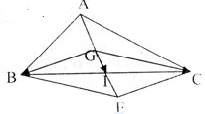Hãy nhập câu hỏi của bạn vào đây, nếu là tài khoản VIP, bạn sẽ được ưu tiên trả lời.

\(\overrightarrow{AB}=\overrightarrow{AG}+\overrightarrow{GB}=\overrightarrow{b}-\overrightarrow{a}\)
\(\overrightarrow{GC}=0-\overrightarrow{GA}-\overrightarrow{GB}=-\overrightarrow{a}-\overrightarrow{b}\)
\(\overrightarrow{BC}=\overrightarrow{BG}+\overrightarrow{GC}=-\overrightarrow{b}-\overrightarrow{a}-\overrightarrow{b}=-\overrightarrow{a}-2\overrightarrow{b}\)
\(\overrightarrow{CA}=\overrightarrow{CG}+\overrightarrow{GA}=\overrightarrow{a}+\overrightarrow{b}+\overrightarrow{a}=2\overrightarrow{a}+\overrightarrow{b}\)

Theo tính chất trọng tâm ta luôn có:
\(\overrightarrow{GA}+\overrightarrow{GB}+\overrightarrow{GC}=\overrightarrow{0}\)
\(\Leftrightarrow\overrightarrow{GC}=-\overrightarrow{GA}-\overrightarrow{GB}=-\overrightarrow{a}-\overrightarrow{b}\)
\(\Rightarrow m=n=-1\Rightarrow m+n=-2\)

Câu 2:
Vì G là trọng tâm nên \(\overrightarrow{GA}+\overrightarrow{GB}+\overrightarrow{GC}=\overrightarrow{0}\)
hay \(\overrightarrow{GC}=-\overrightarrow{a}-\overrightarrow{b}\)
\(\overrightarrow{BC}=\overrightarrow{BG}+\overrightarrow{GC}=-\overrightarrow{b}-\overrightarrow{a}-\overrightarrow{b}=-\overrightarrow{a}-2\overrightarrow{b}\)
=>m=-1; n=-2

Lời giải:
$G$ là trọng tâm tam giác $ABC$ thì ta có 1 bổ đề quen thuộc là:
$\overrightarrow{GA}+\overrightarrow{GB}+\overrightarrow{GC}=\overrightarrow{0}$
$\Leftrightarrow \overrightarrow{a}+\overrightarrow{b}+\overrightarrow{GC}=\overrightarrow{0}$
$\Rightarrow \overrightarrow{GC}=-(\overrightarrow{a}+\overrightarrow{b})$
Ta có:
\(\frac{1}{2}\overrightarrow{AB}-\overrightarrow{BC}=\frac{1}{2}(\overrightarrow{AG}+\overrightarrow{GB})-(\overrightarrow{BG}+\overrightarrow{GC})\)
\(=\frac{1}{2}(-\overrightarrow{a}+\overrightarrow{b})-[-\overrightarrow{b}-(\overrightarrow{a}+\overrightarrow{b})]\)
\(=\frac{\overrightarrow{a}}{2}+\frac{5\overrightarrow{b}}{2}\)

\(\overrightarrow{AG}=\frac{1}{3}\left(\overrightarrow{AB}+\overrightarrow{AC}\right)\Rightarrow\overrightarrow{GA}=-\frac{1}{3}\overrightarrow{AB}-\frac{1}{3}\overrightarrow{AC}=-\frac{1}{3}\overrightarrow{a}-\frac{1}{3}\overrightarrow{b}\)
\(\Rightarrow m=n=-\frac{1}{3}\Rightarrow mn=\frac{1}{9}\)
